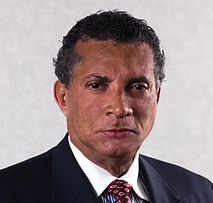
Pebbles are small by definition, but, gathered together, can be used to create a “step up.”
That is the idea behind the theme of the 4th Annual Corporate Equity and Inclusion Roundtable (CEIR) hosted by the Black Political Empowerment Project (B-PEP) and the Greater Pittsburgh Coalition Against Violence (CAV) on Monday at Duquesne University’s Power Ballroom.
Leaders from business, government, education and non-profits were invited to share experience and expertise focused on “Creating Pebbles of Possibilities for Ladders to Opportunities” in order to increase opportunities for people of color, particularly African-Americans, in Southwestern Pennsylvania.
“It is time for each of us to be challenged to act in response to the ongoing negative statistics of our region impacting the economic conditions of African-Americans and people of color,” says Tim Stevens, B-PEP Chairman and Chief Executive Officer. “The good news is there are many initiatives in the Pittsburgh region that have begun to make a difference.”
According to data provided by CEIR, Pittsburgh was reported to be “dead last” in indicators of racial and economic parity by the Post-Gazette in 2010. In 2012, an analysis by the Three Rivers Workforce Investment Board reported that African-Americans are paid less than other groups for the same work. A comparison of professional workforces finds the second-lowest percentage of minorities holding such positions in Pittsburgh when compared to 42 other cities. All of these factors have contributed to the largest wealth gap between whites and minorities in the last 25 years, with white wealth measured at 20 times that of African-Americans, and 18 times that of Hispanics.
In addition to the networking opportunity provided by the conference, focus was placed on both the “Hybrid Rooney Rule,” which is based on an NFL policy requiring that any team hiring a head coach must consider minority candidates as part of the process. In business, the rule would apply not only to executive hires, but to all hiring decisions, as well as to the awarding of supplier and service contracts.
Another focus is on “Ban the Box” initiatives, which ask that employers remove questions about an applicant’s previous felony conviction from the initial form, allowing fair consideration of an individual’s qualifications prior to allowing the individual to explain those convictions later in an interview process. The City of Pittsburgh adopted this policy in 2012, and was joined by Allegheny County in 2014, as have 13 states, the District of Columbia, and nearly 70 other cities and counties. Both Allegheny County Executive Rich Fitzgerald and Pittsburgh Mayor Bill Peduto have encourage local organizations to do the same, saying such a ban would “continue to support our region’s growth and ensure that our workforce statistics reflect a demographic as diverse as our economy.”
Master of Ceremonies Bill Flanagan, Chief Corporate Relations Officer for the Allegheny Conference on Community Development, says “it’s clear that there are people who have been left behind through our region’s transformation over the last generation, especially since the ‘great recession.’ That’s what [CEIR] is about: To make sure nobody is left behind, and everybody has an opportunity to participate.”
Flanagan says the local economic recovery has removed any opportunity for excuses to exclude those who want to participate in success.
“We are a little bit different — maybe a lot different — than we were five years ago,” before the first CEIR was planned, says Fitzgerald. “There were opportunities that were starting to occur back then, but when we look and see where we are now, those opportunities are even greater, as far as jobs and how many people are working; the diversity of our economic opportunities. We need to match that with the diversity of our workforce. I think that is starting to happen.”
Fitzgerald says that as local workers begin to retire, a large number of jobs will become available which, through using “best practices,” could create a far more diverse workforce.
“Our membership told us loud and clear during our last planning cycle that the number one issue they face is that they can’t find enough people to meet their replacement needs, much less their growth needs,” says Dennis Yablonsky, Chief Executive Officer of the Allegheny Conference on Community Development. “We have been working on that for a while, but one of the things we have done over the last year is to really get the facts. We have always known where the jobs are today, but we have never known, and frankly, no other major metro area in the country has known, where they are three, five and ten years from now.”
Working with a consultant who analyzed job postings using details rather than just titles, Yablonsky says “we now have the first of its kind in the country: A forward look at where the jobs are going to be. The good news is, there is opportunity for everybody. The bad news is, if we don’t all pull together on this, the challenge is going to be overwhelming.”
Yablonsky says that, in addition to the nearly 400,000 “Baby Boomers” who will retire in the next ten years, an additional 50,000 new jobs will be created.
“If every kid who comes out of our pre-K to 12 educational system graduates, gets educated and stays in the region, we are 8000 a year short,” Yablonsky says. “That’s a pretty optimistic number, so the opportunity is there. The issue is, how do we address it?”
Yablonsky says a baseball analogy, “ERA,” which stands for “Elevate, Retain and Attract,” is part of the solution.
“Job One is that we have over 100,000 people in this region who are unemployed or underemployed. Many of those people are ready, willing, and with maybe a little bit of ‘up training,’ able to work.”
“The second piece is retention,” says Yablonsky. “We graduate 40,000 young people from our 61 institutions of higher learning in this region every year. Right now, about half of them are staying — about 40 percent from the four-year degree programs and about 62 percent from the two-year. The good news is that that 50 [percent] is a lot better than it was five or ten years ago. The bad news is that other regions retain 60, 65, 70 percent of their graduates.”
“Of the three, the attraction strategy is the most expensive, and the most time consuming,” says Yablonsky. “The easiest way to solve this problem is to elevate and to retain.”
(The report, complete with open-source data, is accessible at alleghenyconference.org/ – News)
Yablonsky also cites “up-credentialing” of job requirements, like requirements for 3-5 years of experience, as barriers.
“Most of the people working at those companies who already perform those jobs would not qualify,” Yablonsky says. “I believe these companies began to write job descriptions because they were in a ‘buyer’s market.’ The second thing that needs to happen is more internships, not only at the four-year baccalaureate level, but also in high schools, so that young people get a better handle on what works for them and what doesn’t. It’s also a great way for businesses to evaluate individuals. “
The Allegheny Conference is also encouraging its member businesses to become more involved with schools from pre-K throughout high school, to help guide those formulating curriculum to including valuable skills.
“We just don’t have enough people here,” Flanagan says. “If we don’t find ways to get more people plugged into the workforce, we really face a challenge. We have to find new and different ways to do things, and it’s important from the human side as well as the economic side.”
John E. Wetzel, Secretary of the Pennsylvania Department of Corrections, offered a Keynote addressing that human side. Wetzel, who was appointed by then-Governor Tom Corbett, was asked to retain his post by Governor Wolf, and is considered a national expert on the effects of incarceration, particularly after reentry.
Having more jobs than people isn’t a problem, but an issue, Wetzel says, and local “ban the box” efforts have created interest not only statewide, but nationally in the criminal justice community.
“Over the past three or four decades, nearly one-third of Americans have a criminal record,” Wetzel says. “The notion that you would exclude one-third of potential applicants — how could that even happen?”
“It is a truism of our approach to criminal justice that it is resulting in the disproportionate incarceration of poor people, of people of color, and that is data, not philosophy,” Wetzel says. “It’s important that we dig a little deeper into that concept, and the concept of how we dig ourselves out.”
“Our prison population in Pennsylvania is going down. Over the past two years, our population has gone down about 1500 inmates, and when I inherited this job, it was growing by 1500 a year,” says Wetzel. “We have been fortunate, with the aid of a lot of partnerships, to start reducing that trend. What that means is that more and more people are coming out of prison, probably at least 2000 people, coming back to [southwestern Pennsylvania], 1000 in particular to Allegheny County. It’s a large number, and they are disproportionately poor and people of color.”
“[Disproportionate incarceration] impacts the community: We break up the family, we break up the community supports that keep people on the right track, we decimate the population,” Wetzel says. “How do we bounce back? We focus on building social community support and economic opportunity, and you have a really unique opportunity.”
“When I hear ‘Ban the Box,’ it’s us, as a community, saying that people are worthy, and that people have humanity, even if they are incarcerated,” Wetzel says. “We have 50,000 people incarcerated, and 90 percent of them are going to come back home. Some of those people are going to move into neighborhoods close to you, and an important question to ask ourselves is, how do we want those people to come back? Do we want them coming back with no skills, and no opportunity other than committing crime?”
Wetzel says he would rather consider the $42,000 per year spent to incarcerate an inmate an investment by providing skills and services to facilitate successful re-entry.
“We have the ability to provide training, and develop skills they can use,” Wetzel says. “We created six programs across the state to develop the skill sets for people to work on gas pipelines. We can partner with anybody. We can set up a program where individuals can come back and get plugged in to the workforce. We are committed to creative solutions,” although he admits not all 2000 who return will be employable in all industries.
“It’s essential, because it’s the right thing to do,” Wetzel says. “What Ban the Box does is give us the ability to not pre-judge people. Interview them, and make your judgment based on the totality of the facts, not just a box that is checked on a paper. Horrendous public mistakes are not a legacy. Individuals re-entering can join in strategic partnerships that businesses should be embracing.”
“We are all collectively invested in this,” Wetzel says.
Several panel discussions were hosted to inform audience members about other ways to create and promote diversity in the workplace, from hiring decisions to choosing suppliers and contractors. At the conclusion of the roundtable, Stevens urged those in attendance to contribute a pebble, a commitment to make positive change to increase economic involvement for everyone.
“Change is about to begin,” Stevens says. “Change begins with pebbles of possibilities. With initiatives that are aimed at making a difference in our businesses, in our colleges, in our universities, in our non-profits, in our communities.”
For more information about the Corporate Equity and Inclusion Roundtable, including links to resource materials, visit b-pep.net/ -! blank/um691.
By Nancy Hart
Twitter: @nhart543






































